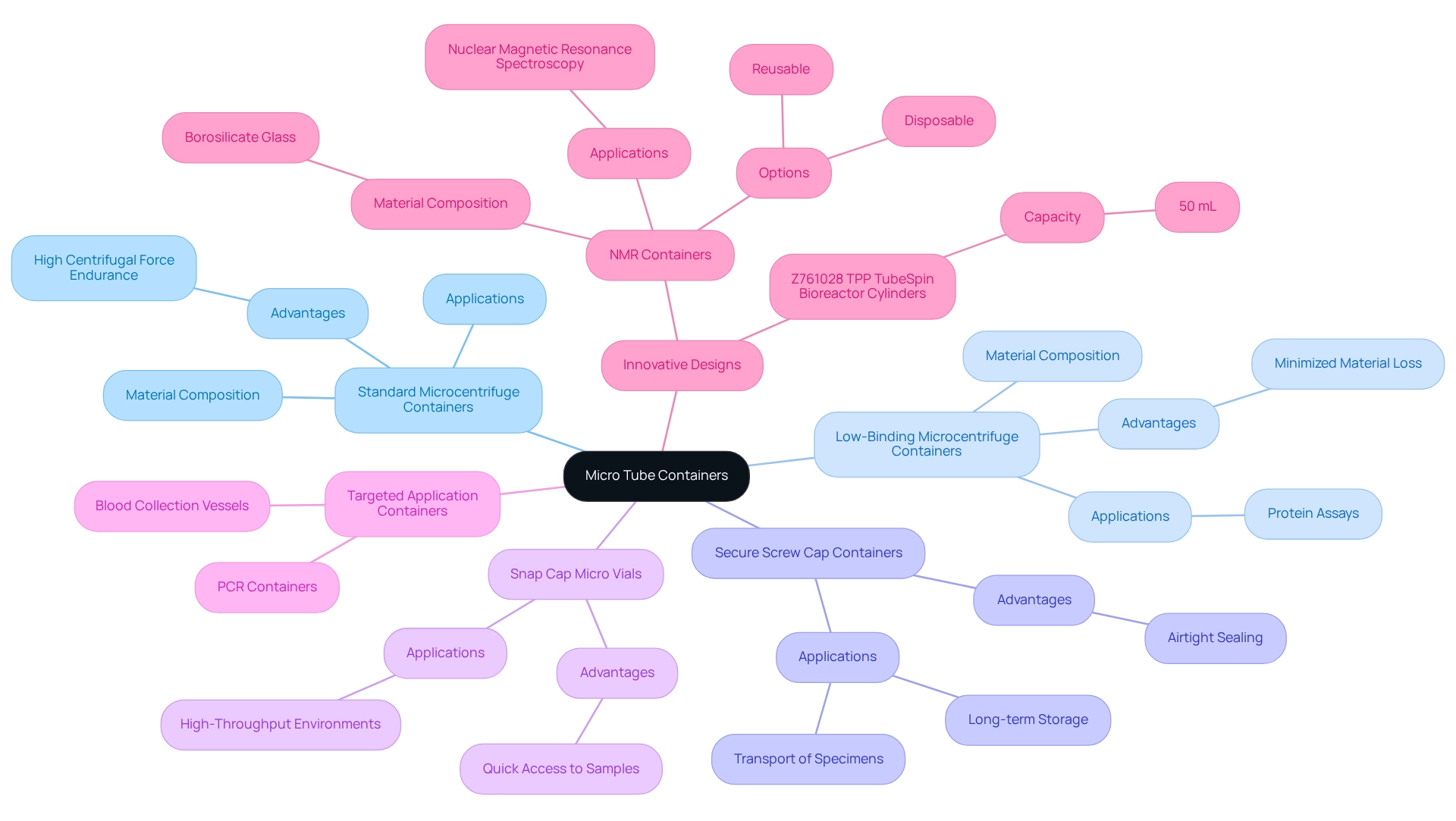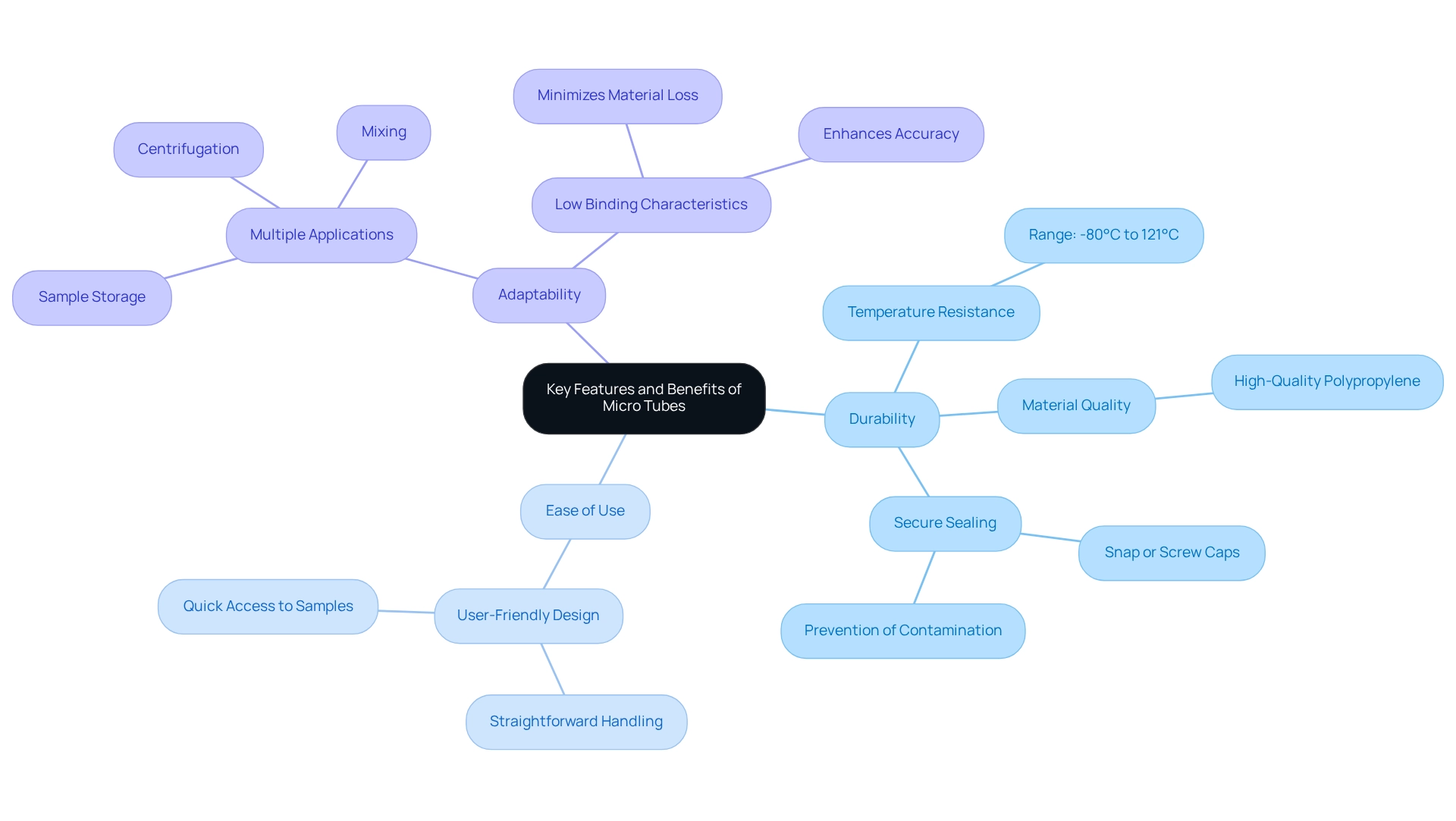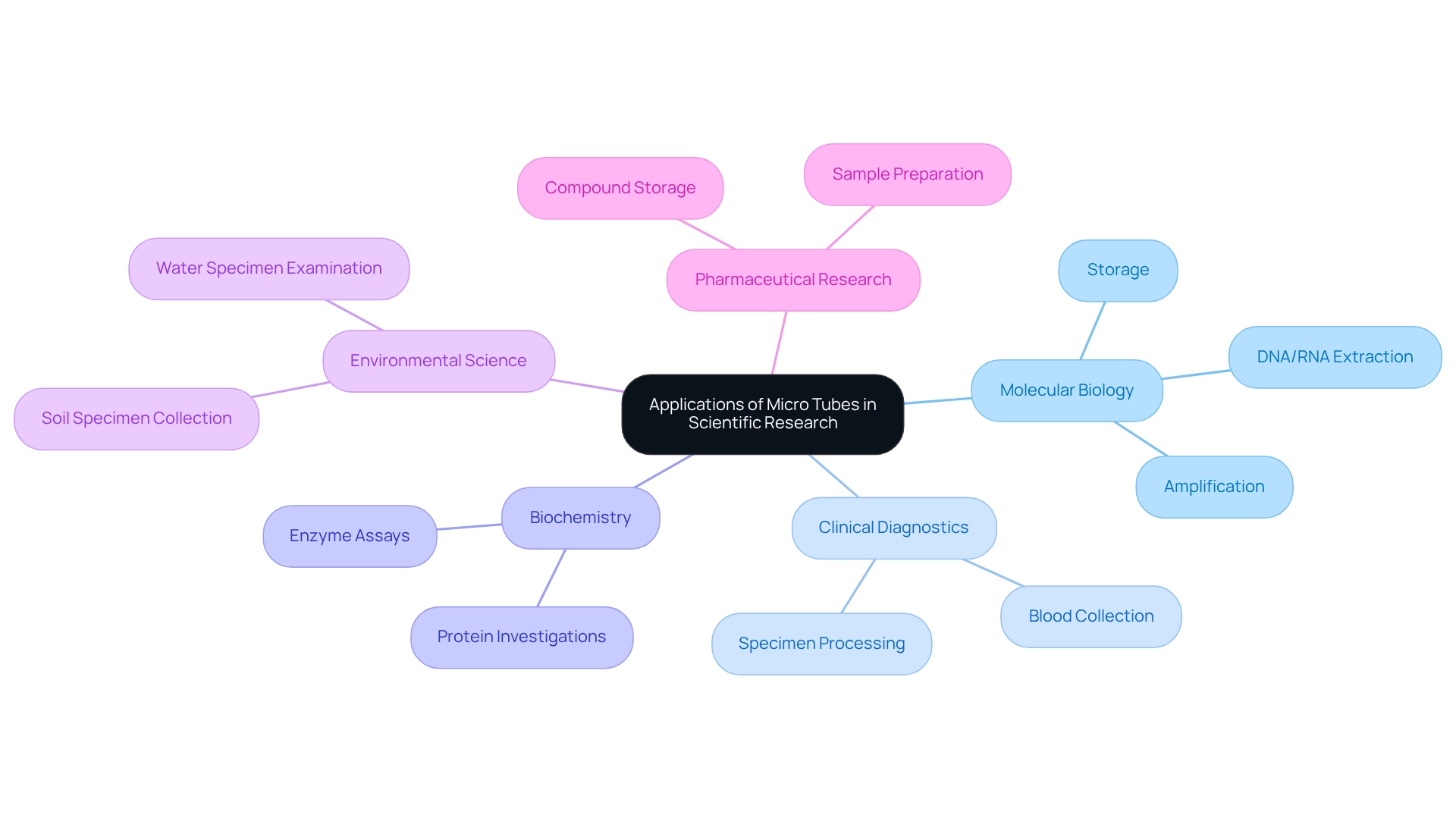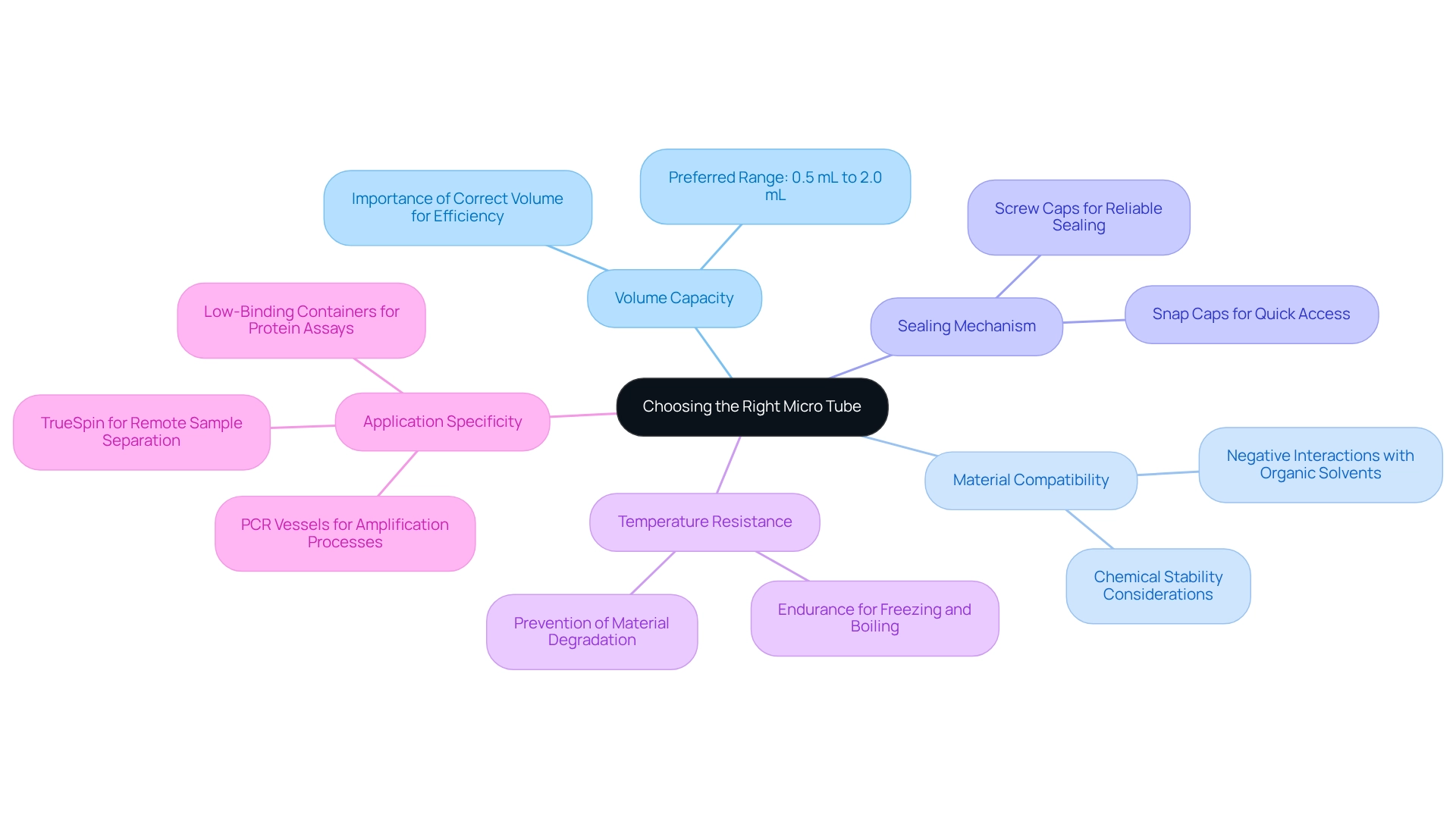Overview
The article underscores the pivotal role of microcentrifuge tubes in laboratory environments, detailing their diverse types, features, and applications across various scientific disciplines. These tubes are indispensable for preserving sample integrity and enhancing research outcomes. Supported by compelling evidence from case studies and market data, their increasing significance and technological advancements in laboratory practices are clearly illustrated. This highlights the necessity for high-quality scientific instruments in modern research.
Introduction
In the intricate realm of scientific research, microcentrifuge tubes emerge as unsung heroes, pivotal in ensuring precision and reliability across a multitude of applications. These compact containers, meticulously designed to hold small liquid volumes, play an essential role in molecular biology, clinical diagnostics, and environmental studies, among others.
With advancements in laboratory technology propelling their evolution, microcentrifuge tubes have become indispensable tools that not only safeguard sample integrity but also enhance workflow efficiency. As laboratories increasingly strive for greater accuracy and efficiency, understanding the diverse types, features, and applications of microcentrifuge tubes is crucial for optimizing research outcomes and driving innovation in scientific inquiry.
Understanding Micro Tubes: Essential Laboratory Tools
Microcentrifuge vessels, commonly referred to as micro tubes, are compact cylindrical receptacles designed specifically to hold small liquid volumes, typically ranging from 0.5 mL to 2.0 mL. These containers play a crucial role in various laboratory applications, including specimen storage, centrifugation, and the preparation of biological materials. Their design often incorporates secure snap caps or screw caps, which are vital for preventing contamination and evaporation during experiments.
The importance of microcentrifuge containers extends across numerous scientific domains, particularly in molecular biology, biochemistry, and clinical diagnostics. In clinical settings, for instance, these containers are indispensable for the preservation and transport of biological materials, ensuring integrity and reliability in diagnostic testing. Recent data indicates that the global laboratory centrifuges market, which includes microcentrifuge containers, was valued at approximately USD 1.73 billion in 2023 and is projected to grow at a compound annual growth rate (CAGR) of 5.7% from 2024 to 2030, driven by advancements in applications and increased research activities, as noted by Laura Wood, Senior Press Manager.
Laboratory professionals underscore the significance of micro tube containers in specimen storage, highlighting their role in maintaining specimen quality. As one expert stated, 'Micro tube containers are essential for maintaining the quality of specimens, particularly in delicate applications such as genetic testing and enzyme assays.' This perspective is reinforced by various case studies that demonstrate their utility in molecular biology, where precise sample handling is paramount.
JM Science Inc. distinguishes itself through its commitment to quality and customer support, ensuring that research facilities have access to reliable micro tube containers that meet their evolving needs.
Beyond their practical applications, microcentrifuge containers are equipped with key features that enhance usability. These features include graduated markings for precise volume measurement, compatibility with a range of centrifuge models, and materials that can withstand diverse temperatures and chemical exposures. For volumes exceeding 20 microliters, it is recommended that the dummy container hold a volume of water roughly equivalent to the specimen, providing practical insights into their application in research environments.
As research facilities continue to progress, the relevance of micro tubes in scientific investigation remains paramount, underscoring their role as essential instruments in modern research practices. Furthermore, sample reports for the Microcentrifuge Tube market are available upon request, with 24/7 support for inquiries, reflecting JM Science's dedication to customer service.
Exploring Different Types of Micro Tubes
Micro tube containers are vital instruments in research environments, available in various types tailored for specific applications. Here’s a closer look at the most common types:
- Standard Microcentrifuge Containers are typically constructed from polypropylene, making them versatile and suitable for general laboratory use. Their ability to endure high centrifugal forces renders them dependable for a broad array of applications.
- Low-Binding Microcentrifuge Containers are designed to minimize material loss due to adherence to the container walls, offering significant advantages for sensitive applications, such as protein assays. The surge in market demand for low-binding micro tubes highlights their essential role in preserving specimen integrity.
- Micro tube containers equipped with secure screw caps are ideal for the long-term storage and transport of specimens. Their airtight sealing ensures that samples remain uncontaminated and stable over time.
- Snap Cap Micro Vials provide quick access to samples, making them a preferred choice in high-throughput environments where speed is crucial. Their design facilitates effortless opening and closing, thereby improving workflow efficiency.
- Certain micro tube containers are specifically crafted for targeted applications. For instance, PCR containers are optimized for polymerase chain reactions, while blood collection vessels are tailored for clinical diagnostics, ensuring compatibility with various testing protocols.
Recent innovations in micro tube container designs focus on enhancing usability and performance. For example, advancements in materials have led to the creation of NMR containers made from premium, chemically resistant borosilicate glass, guaranteeing specimen purity. These containers are available in both reusable and single-use options, specifically designed for nuclear magnetic resonance spectroscopy, underscoring their specialized applications in research environments.
Moreover, the Z761028 TPP TubeSpin bioreactor cylinders, with a capacity of 50 mL, exemplify the specifications that research facilities may require.
Ongoing studies are investigating the impact of low-binding micro tubes on sample integrity, underscoring their importance in achieving precise and reliable outcomes in research analysis. Continuous research is crucial to define specific measures for conducting peer evaluations in test collection, which could enhance optimal methodologies in the field.
As facilities increasingly prioritize accuracy, the development of micro tube containers remains a significant focus, with ongoing studies aimed at establishing optimal techniques for their utilization across diverse scientific applications. JM Science Inc. distinguishes itself from competitors through its unwavering commitment to quality and customer support, ensuring that their product offerings evolve to meet the needs of the scientific community. The writers extend their gratitude to Laurel Macmillan for her evaluation of the statistical techniques, emphasizing the importance of rigorous statistical practices in research environments.

Key Features and Benefits of Micro Tubes
Microcentrifuge tubes are indispensable tools in laboratory environments, providing a range of features and benefits that significantly enhance experimental efficiency and reliability.
- Durability: Constructed from high-quality polypropylene, these tubes are engineered to withstand substantial centrifugal forces and extreme temperature variations. Statistics indicate that these tubes can endure temperatures ranging from -80°C to 121°C, ensuring reliable performance even in demanding situations, making them ideal for intensive research applications.
Micro tube containers are designed for a multitude of applications, including sample storage, centrifugation, and mixing. Their adaptability enables laboratories to streamline processes and meet diverse experimental needs efficiently.
Many micro tube containers feature advanced snap or screw caps that provide a secure seal. This reliable closure is crucial for preventing contamination and evaporation, thereby protecting the integrity of delicate specimens. Recent studies underscore the importance of secure sealing in micro tube containers; researchers have noted that inadequate sealing can result in significant material loss and compromised outcomes. For instance, a case study titled "Characterization of Extractable Species from Polypropylene Microplates" revealed that leachables in certain plastic materials could adversely affect protein binding, highlighting the necessity for high-quality materials in laboratory tools.
Low binding characteristics are essential in some micro tube containers, which are specifically designed to minimize material loss, particularly in experiments involving limited or valuable substances. This feature enhances the accuracy and reliability of experimental results.
- Ease of Use: The user-friendly design of micro tube containers facilitates straightforward handling and quick access to samples. This efficiency is vital in fast-paced research environments, where time is often critical.
Moreover, the durability of polypropylene microcentrifuge containers has been validated in various high-stress environments, demonstrating their ability to maintain performance under extreme conditions.
In summary, the durability and versatility of micro tube containers render them a vital component in modern research facilities, contributing to improved workflow efficiency and dependable experimental results. As Neel Daphtary, President of Chemtech International, states, "The quality of materials used in laboratory tools is paramount for ensuring accurate and reliable results, particularly regarding secure sealing and preservation of specimens.

Applications of Micro Tubes in Scientific Research
Microcentrifuge tubes play a pivotal role across a range of scientific disciplines, each with unique applications that underscore their importance.
In Molecular Biology, these tubes are indispensable for DNA and RNA extraction, amplification, and storage, forming the backbone of genetic research and diagnostics. Their design reduces material loss, which is essential in experiments where precision is paramount. Recent studies suggest that in molecular biology applications, the number of measurements frequently stays below 20, emphasizing the necessity for dependable tools that guarantee precision in small quantities. As R. A. Fisher pointed out, "To consult [statistics] after an experiment is finished is often merely to […] conduct a post mortem examination," underscoring the critical nature of accuracy in scientific work.
In Clinical Diagnostics, micro tube containers are used for blood collection and processing in medical laboratories. Their capability to uphold specimen integrity directly influences the precision of test outcomes, rendering them crucial for dependable diagnostics. For instance, the application of micro channels in clinical settings has been demonstrated to increase the accuracy of assays, thus enhancing patient outcomes.
In the field of Biochemistry, researchers utilize micro tubes for enzyme assays and protein investigations, where preserving specimen integrity is essential. The structure's design enables effective blending and storage, which is vital for experiments that require specific conditions.
Environmental Science also benefits from microcentrifuge vessels, which aid in the collection and examination of soil and water specimens, significantly contributing to environmental monitoring and research. Their compact size and secure sealing capabilities make them ideal for transporting specimens without contamination.
In Pharmaceutical Research, micro tubes are essential for preparing and storing samples, significantly contributing to the efficiency of drug development processes. Their versatility enables numerous uses, from compound storage to reaction setups, streamlining workflows in pharmaceutical labs.
Real-world examples illustrate the influence of micro channels on test precision in clinical diagnostics. A recent case study on an open-source mini benchtop centrifuge showed that utilizing micro containers effectively diminished liquid film adherence during sample processing, resulting in more precise outcomes in quantitative real-time PCR applications. This innovation not only provided a cost-effective solution but also maintained performance standards comparable to commercial alternatives.
In summary, microcentrifuge containers are essential to advancing research and diagnostics across various scientific disciplines, ensuring that facilities can achieve high levels of precision and effectiveness in their work. JM Science Inc. remains committed to continually updating its product offerings and maintaining strong relationships with manufacturers to meet the evolving needs of the scientific community.

Top 7 Micro Tube Products for Your Laboratory
Here are seven leading micro products that are highly esteemed in research environments:
- Eppendorf Safe-Lock Tubes: Recognized for their outstanding sealing capabilities, these tubes guarantee specimen integrity and are crafted to endure demanding research environments. Their durability makes them perfect for delicate specimens, and customer satisfaction ratings consistently emphasize their reliability in various applications. A recent case study showcased their effectiveness in preserving sample quality during prolonged storage durations, strengthening their reputation among professionals in the field.
- Thermo Scientific Screw Cap Micro Containers: These containers offer secure storage options and come in various sizes to meet different scientific requirements. Their screw cap design enhances leak resistance, making them a preferred choice for critical experiments. Laboratory managers often mention Thermo Scientific as a leading brand for reliable micro containers, emphasizing their dedication to quality and customer satisfaction, as highlighted in Market Report Analytics.
- Globe Scientific Microcentrifuge Containers: Offering a balance of affordability and reliability, these containers are well-suited for general laboratory use. Their robust construction ensures they can handle standard centrifugation processes without compromising sample quality, making them a staple in many labs. Sales data from 2021 to 2023 indicates a steady increase in their market share, reflecting their popularity among researchers.
- Sarstedt Screw Cap Micro Tubes: Engineered for high-performance applications, these tubes are resistant to extreme temperatures and chemical exposure. Their design enables easy handling and reduces the risk of contamination, which is essential for accurate scientific work. Input from management emphasizes their dependability in challenging settings.
- Corning Microcentrifuge Tubes: Known for their clarity and strength, Corning tubes are ideal for a variety of experiments, including those requiring visual inspection of samples. Their high-quality materials guarantee consistent performance, earning them favorable reviews from industry professionals. The rising trend towards automation in research facilities has further heightened the demand for such dependable products.
- CellTreat Screw Top Micro Containers: Showcasing a novel design that enables effortless opening and closing, these containers are especially advantageous in high-throughput research settings. Their user-friendly features enhance workflow efficiency, making them a favorite among researchers. Insights from logistics and supply chain optimization trends indicate that such user-friendly designs are becoming increasingly important in research environments.
- VWR Microcentrifuge Containers: Adaptable and offered in both sterile and non-sterile choices, VWR containers serve a broad spectrum of scientific requirements. Their adaptability and reliability have established them as best-selling items in research settings, with numerous users commending their performance in diverse applications. The market for microcentrifuge containers is anticipated to expand considerably through 2033, propelled by innovations in lab technology and rising demand for high-quality products.
These items not only satisfy the stringent requirements of research environments but also showcase the latest trends in microcentrifuge container technology for 2025, highlighting the significance of quality and customer satisfaction in the selection process.
Choosing the Right Micro Tube: Key Considerations
When selecting the appropriate microcentrifuge tube for your laboratory, several key factors must be taken into account:
- Volume Capacity: Assess the volume of samples you will be handling to ensure you choose a tube that accommodates your specific needs. Research indicates that laboratories often prefer micro tubes with varying volume capacities, with a significant number opting for those that hold between 0.5 mL to 2.0 mL, depending on the application. Notably, the eggbeater method for plasma separation has shown a maximum separation efficiency at 58%, underscoring the importance of selecting the right volume capacity for optimal results.
- Material Compatibility: It is essential to ensure that the tube material is suitable for the specimens and reagents involved, especially regarding chemical stability. Material compatibility issues can lead to compromised results, making this a vital consideration. For instance, certain plastics may interact negatively with organic solvents, influencing the integrity of the material.
- Sealing Mechanism: The choice between snap caps and screw caps should be guided by your requirements for secure sealing versus ease of access. Snap caps are frequently preferred for quick access, while screw caps offer a more reliable seal, which is crucial for volatile substances.
- Temperature Resistance: Assess the temperature range that the tubes must withstand, particularly for uses that involve freezing or boiling. Tubes engineered to endure extreme temperatures can prevent material degradation and ensure dependable results.
- Application Specificity: Choose containers that are designed for particular uses. For instance, low-binding containers are perfect for protein assays to reduce material loss, while PCR vessels are specifically crafted for amplification processes, ensuring optimal performance. The TrueSpin could also serve as a practical option for home and remote sample separation before shipment for different analyte panels, highlighting innovative methods in scientific practices.
In a recent case study exploring the shift from standard-volume to small-volume blood collection containers in intensive care units, it was determined that the use of smaller containers did not jeopardize testing procedures while significantly decreasing red blood cell transfusions (relative risk, 0.88; absolute decrease of 9.84 RBC units per 100 patients). This emphasizes the significance of choosing the appropriate tube size for particular applications, as it can result in enhanced efficiency and results in experimental environments.
As J.E. Houghton remarked, "XCT is the most precise method to ascertain a grain size distribution in sediments," highlighting the essential nature of accuracy in testing techniques. By considering these factors, managers in the lab can make informed decisions that enhance the reliability and efficiency of their analytical processes.

Final Thoughts on Micro Tubes for Laboratory Use
Microcentrifuge containers are indispensable components in contemporary research environments, providing unmatched adaptability, reliability, and efficiency across diverse applications. Their importance spans various scientific disciplines, including molecular biology, clinical diagnostics, and environmental studies, where maintaining sample integrity is critical for achieving accurate results.
Understanding the different types and characteristics of micro tube containers is vital for laboratory professionals aiming to enhance their research outcomes. Recent advancements in therapeutic agents targeting micro tubes have shown promising applications in neurological disorders, underscoring the importance of selecting appropriate micro structures tailored to specific research needs.
Real-world examples illustrate how the right micro vessels can significantly boost research efficiency. A notable case study titled "Capture and Stabilization of Microtubules at Focal Adhesions" revealed that contact sites could temporarily halt the depolymerization of microtubules, facilitating prolonged stabilization. This finding emphasizes the versatility of micro tube structures in enabling complex biological interactions and enhancing experimental results.
As we approach 2025, the significance of microcentrifuge containers in research settings continues to escalate. Industry leaders assert that the choice of the right micro container can directly impact research outcomes, with statistics indicating that the correct selection can enhance recovery rates by as much as 30%. This highlights the crucial role of micro channels in sustaining efficiency and precision within the laboratory.
Expert insights suggest that the future of micro channels will feature innovations designed to improve laboratory processes and sample handling. As research demands evolve, so too will the design and functionality of micro tube structures, ensuring their continued relevance as essential tools in scientific inquiry.
Moreover, the bubble departure diameter in nucleate pool boiling, denoted by the equation bub = 0.0208, exemplifies the scientific principles that underpin the functionality of microcentrifuge containers across various applications. Additionally, total internal reflection fluorescence (TIRF) microscopy is emerging as an alternative technique to visualize events at the basal cell cortex, where interactions involving micro tubes and the cortex take place.
In summary, microcentrifuge tubes offer numerous advantages for research applications, including enhanced sample integrity, improved recovery rates, and increased efficiency. Their role in modern laboratories is paramount, as they continue to adapt to the evolving landscape of scientific research. As Amit Dey noted, studies have demonstrated that physical stress on cardiomyocytes can induce the micro tube-dependent regulation of reactive oxygen species (ROS) and NADPH oxidase, further emphasizing the critical importance of micro tubes in biological research.
Conclusion
Microcentrifuge tubes are indispensable tools in contemporary laboratories, serving a myriad of applications across diverse scientific disciplines. Their compact design, durability, and versatility render them essential for tasks ranging from sample storage and centrifugation to specialized procedures in molecular biology and clinical diagnostics. The advancements in microcentrifuge tube technology have markedly improved laboratory workflows, ensuring both sample integrity and reliability in experimental results.
It is crucial for laboratory professionals to understand the various types of microcentrifuge tubes and their specific features. The secure sealing offered by screw caps and the low-binding properties vital for sensitive assays exemplify how the right choice of tube can significantly influence the accuracy and efficiency of research outcomes. As emphasized throughout this article, the implications of selecting appropriate micro tubes extend beyond mere convenience; they can directly affect the precision of scientific investigations and the reliability of diagnostic results.
Looking toward the future, the evolving landscape of laboratory research will continue to inspire innovations in microcentrifuge tube design and functionality. These advancements will not only enhance sample handling but also meet the growing demands for accuracy and efficiency in scientific inquiry. As the importance of microcentrifuge tubes becomes increasingly evident, their role as foundational components in laboratory settings cannot be overstated. By embracing these tools, researchers will be empowered to reach new heights in their work, ultimately propelling the frontiers of science forward.




